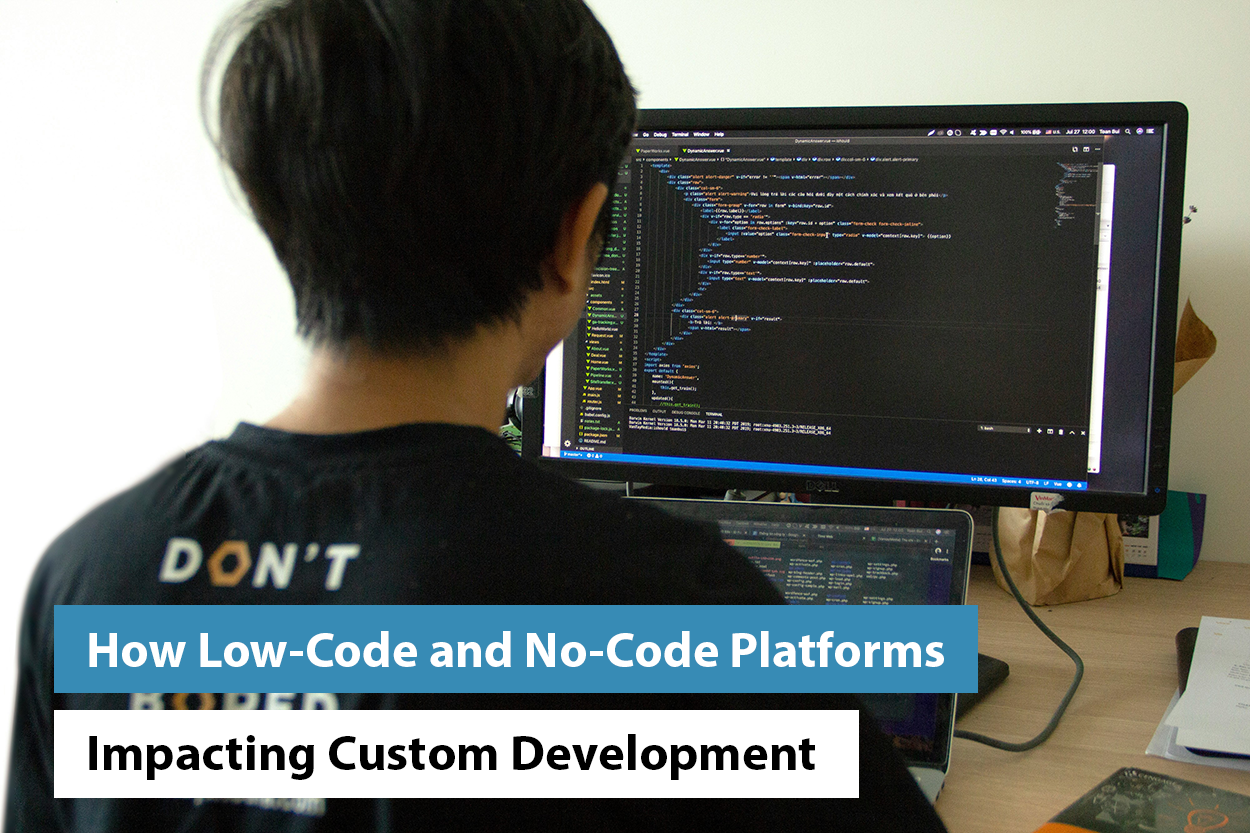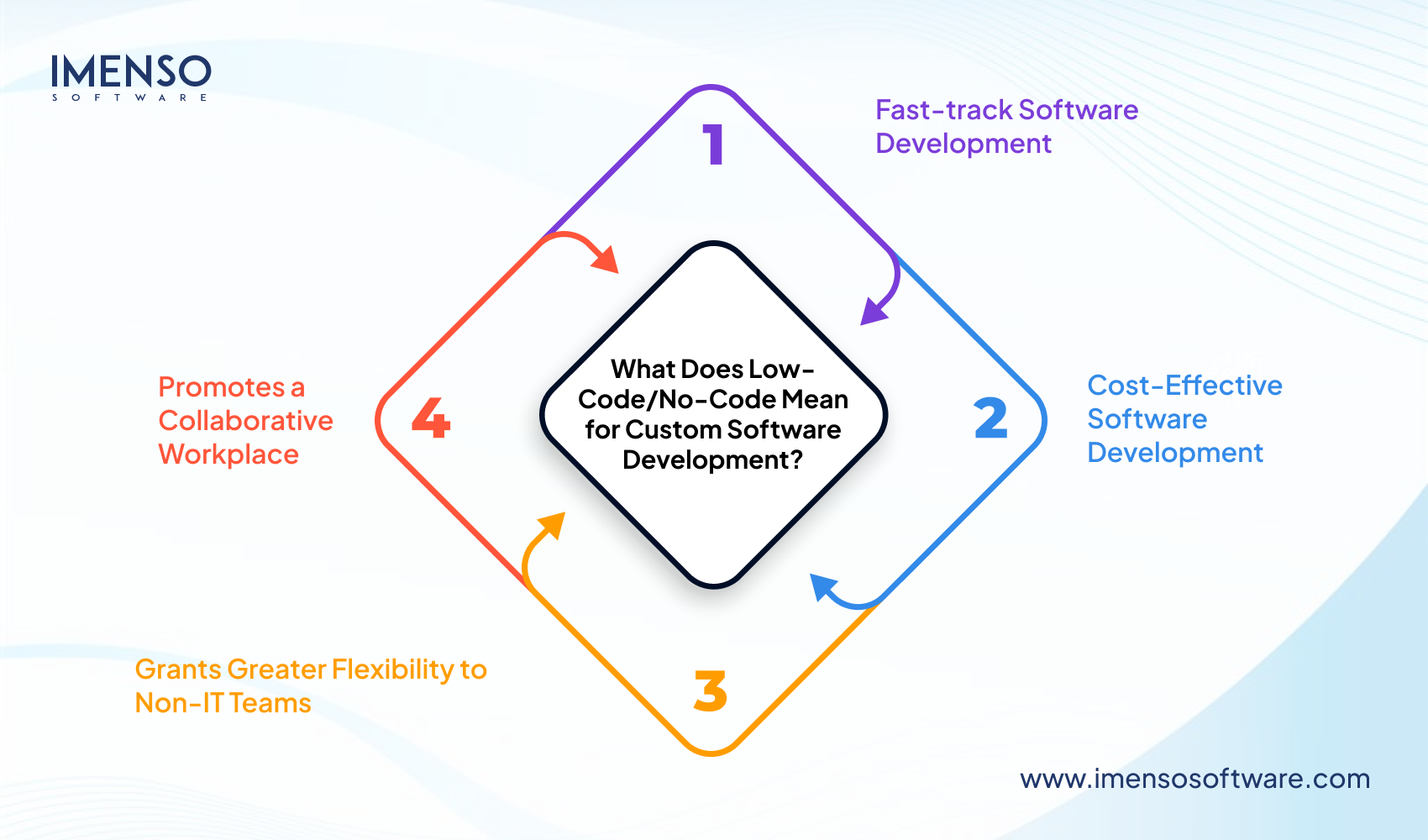How Low-Code and No-Code Platforms Are Impacting Custom Development

Businesses have, for decades, taken one of these two routes to app development. They either buy ready-made apps or build them from scratch. But times have swiftly changed.
Today, the need for IT modernization and hyperautomation has grown. Organizations that don’t keep up with these trends are bound to lag and eventually fail.
The best solution for it?
Low-code no-code platforms.
These systems allow you to build apps without the need for coding. All you have to do is use their drag-and-drop features. Just a few clicks of these buttons and you end up with professional mobile and web apps.
Low-code/no-code platforms undoubtedly facilitate IT transformation. But how do they impact the custom software development?
Let’s find out more about them below.
Almost 60% of custom enterprise apps are built by non-developers. 30% of them are built by employees with basic or zero technical development skills.
-TechRepublic
What is Low-Code Application Development
Low-code is an app development approach that enhances coding from textual to visual. A low-code platform works in a drag-and-drop interface. People of all skill levels can use low-code to build modern business apps.
Below are some common low-code use cases:
- Mobile apps
- Portal development
- Workflow automation
- Legacy modernization
Low-code application development platforms (LCAPs) abstract and automate the entire application lifecycle. They make development more accessible to people with basic tech skills. The features present in low-code platforms expedite the development process.
How Low-Code Platforms Accelerate End-to-End Application Development
Low-code systems enhance app creation in various ways. This is made possible by their features. Let’s go over the most common functionalities in low-code platforms.

a. Visual Modeling
Drag-and-drop feature and an intuitive visual UI allow IT specialists to get more done in less time. Citizen developers benefit by being able to build all types of apps.
Low-code systems operate on model-driven development (MDD). This is an approach where apps are designed and built via visual models. There’s no room for extensive lines of code. The user can visualize how the app works as it’s being built. At the same time, they can launch it with one-click deployment.
b. Reusable Components
You can build cross-platform apps with pre-configured modules, logic, templates, and more. IT specialists can customize and enhance the elements of a low-code app.
c. Collaboration Tools
Low-code platform promotes collaborative app creation with built-in tools. Tools are present for feedback loops, revision tracking, and messaging, among other things. The visual nature of low-code keeps technical and non-technical teams on the same page.
d. Scalable Environments
47% of businesses are concerned about the scalability of their apps. With a low coding system, you can deploy new apps quickly. It also enhances existing ones as per the changes in customer and business needs.
e. Data Integration
Low-code platforms allow you to securely merge data and logic from any system, source, or service. Businesses can build apps using pre-configured APIs and connectors. Alternatively, you can train your IT team to create a custom integration.
f. Application Lifecycle Management
Low-code supports every stage of the app creation lifecycle. It has tools to simplify project management, version control, testing, and more. These systems run on Agile practices and DevOps tools.
Organizations with citizen developers score 33% higher on innovation measures.
McKinsey & Company
What Is No-Code Application Development?
No-code is a software development method that lets users create apps and automate business workflows. All this, without writing a single line of code. Its drag-and-drop tools and visual interfaces allow non-technical users to create dynamic software. Not only that, but it also lets citizen developers test and release custom solutions. Here are some use cases of no-code platforms:
- Internal dashboards to track KPIs.
- Mobile and web apps
- Self-service platforms
- AI-powered chatbots
No-code development democratizes software creation. It empowers non-technical business users to quickly build and launch solutions tailored to their needs.
How No-Code Platforms Simplify Visual App Design
Like low-code platforms, much of the impact of no-code systems comes from their features. Here’s a look at some key features that they have.
Visual App Design Tools
No-code platforms have intuitive visual app design tools. These make way for efficient app development. These platforms have a rich library of pre-built components. These include forms, buttons, and data tables. These components rapidly assemble and create functional and visually pleasing apps.
Workflow Automation Tools
No-code platforms feature advanced workflow automation tools. This leads to streamlining of key business functions. With no-code systems, companies can quickly automate repetitive tasks and processes. They can decrease manual errors and boost efficiency. Drag-and-drop interfaces allow businesses to create automated workflows for operations like approval processes and task assignments.
Dashboards For Analytics And Reporting
No-code platforms offer tools for creating custom dashboards and reports. You can design analytics dashboards with just a few clicks. It lets you pull data from various sources to track KPIs. This enhances data analysis. It has a crucial far far-reaching impact of enabling businesses to make data-driven decisions efficiently and timely.
API And Third-Party Integration Capabilities
No-code platforms have API support and third-party integration capabilities. It makes way for smooth connections with external systems and services. No-code support extends to both API consumption and publishing. They have pre-built connectors and API tools. So, you can link your apps with systems such as databases, CRM platforms, and other software.
AI And Machine Learning Integration
Enterprise-grade no-code systems integrate AI and ML into their solutions. So, businesses can tap into the benefits of these technologies without special expertise. AI/ML features unlock powerful functionalities. These include predictive analytics, NLP, and data classification.
Around 60% of company managers consider no-code platforms “critical to very critical” for their business operations and strategy.
-KPMG 2022 Survey
Difference Between Low-Code and No-Code Platforms
| S.No. | Low Code | No Code |
| Target Users | Low-code is more for skilled IT specialists. It lets them replicate the basic code and create room for more complex aspects of development. In doing so, they promote developer reskilling. | No-code is aimed at non-technical or citizen developers. They are ideal for those who cannot write manual lines of code. However, these people know how to perform basic tech-driven systems. |
| Use Cases | A low-code platform with a rich component library is more fitting for apps with complex business logic. If you want dynamic apps that can integrate with other software and link to many data sources, low-code systems will be the best. | No-code is better suited for front-end apps that can be quickly created by drag-and-drop interfaces. UI apps that pull data from sources and report are best designed with no-code platforms. Besides, these systems also lend themselves well to internal apps that don’t have extensive features. No-code platforms can efficiently create small-scale apps for businesses on a tight budget. |
| Development Time | Low-code platforms are a bit more complex than no-code. So, they need more training for users. You require more time to develop and deploy apps using low code. This is also because once created, there’s more room for customizing the app. So, compared with no-code, the app development time is longer. | No-code platforms are largely plug-and-play systems. As already mentioned, they take less time to build than low-code. Since there is zero manual coding, the chances of errors are less. It, in turn, lowers the testing time. |
| Open Vs. Closed Systems | Low-code development platforms are open systems. It means that users can enhance their features through code. Low-code platforms are thus highly reusable and flexible. The only downside is that any new update to them will require testing with new manual code. | No-code is a closed system. You can only extend it with templated feature sets. This reduces the number of its use cases. However, because of zero manual code, ensuring backward compatibility is easier. |
| Infrastructure Scope | Low-code platforms are highly scalable. They are also cross-platform compatible. Users can add custom code and plugins. This greatly enhances the app’s usability. | The architecture range of no-code systems isn’t as extensive as that of low-code. They have limited capabilities to link to legacy systems and other apps. No-code platforms aren’t as scalable and have fewer use cases. |
What Does Low-Code/No-Code Mean for Custom Software Development?
“I’m a terrible developer.” “I’ve always dreamed of building great software that people love, but instead, I end up swearing at my computer and abandoning projects as soon as I get stuck. But about eight months ago, this changed when a friend showed me a bunch of ‘no-code’ tools like Bubble, Typeform and Blockspring. After a few months of learning, I challenged myself to make an Airbnb clone without writing code. Ten hours later, I was done, I was tired, and I was hooked.”
Brent Summers, a technologist and the founder of Code-Free Startup.
Summers wrote this comment on the Product Hunt page of his tool.
This anecdote clearly explains the profound impact of low-code and no-code platforms. What’s remarkable is that they are changing the lives of programmers and non-programmers alike. Due to their abstraction, almost anyone can quickly create common apps and tailor them to their needs. Put simply, these platforms offer value to everyone.
In doing so, they are disrupting custom software development. Below are some of the key ways in which you can notice their impact.

1. Fast-track Software Development
Custom software development usually requires much manual coding. Moreover, once the product is in production, changing it isn’t easy. Low-code and no-code platforms have entirely altered this situation. They are packed with features that are perfect for businesses that need swift app deployment.
Another benefit of these platforms is that they allow IT specialists to create complex apps visually. This expedites prototype creation. So, the IT team spends less time on intricate coding and wireframes. The rich code libraries in these platforms further reduce the app creation time.
2. Cost-Effective Software Development
Gathering a team of skilled IT specialists isn’t cheap. Hiring and retaining such people usually eats up the budget of many small and medium-sized companies. Not only that, but building an app is a long process. The more time it takes, the more money you invest.
Low-code no-code platforms eliminate the need of having skilled developers to a large extent. Since they let users create and release apps quickly, it increases a business’s competitive edge. Costs are further cut because you don’t need to invest in infrastructure and hardware as much as with conventional custom development.
A no-code low-code platform is user-friendly. So, there’s less need to extensively train users. This, in turn, leads to easier maintenance of the app.
3. Grants Greater Flexibility to Non-IT Teams
Low-code/no-code systems allow businesses to remain agile in the dynamic landscape. Gone are the days when non-IT staff had to depend on the IT team for every single technology for work. Features like drag-and-drop, point-and-click, and more allow the average business user to become a citizen developer.
Low coding demands minimal programming expertise. It can be fully customized within a defined framework and API. This approach saves money and time on deployment. It allows IT specialists to work on more strategic things. According to Forrester’s research, 80% of businesses agree that low-code solutions free developers’ time. It lets them focus on higher-level projects.
4. Promotes a Collaborative Workplace
Low-code/no-code systems break down the barriers between IT and non-IT teams. They thus promote greater collaboration. This, in turn, leads to better solutions and systematic development. Non-IT staff can offer insights on development. IT teams can ensure that apps remain scalable and secure.
Many low-code and no-code platforms have features for real-time collaboration. They let various users work on the same app at the same time.
The Future of Low-Code/No-Code Development
Low-code/no-code platforms are fast making a world where anyone can create software a reality. One thing is for sure. They will empower more people to build apps. This, in turn, will ensure that no one holds the key to tech innovation.
What is making the impact of low-code no-code platforms more disruptive is the rise of generative AI through large language models (LLMs). The market size of low-code platforms is expected to grow massively. By 2028, it can potentially reach $94.75 billion. This expansion will be a result of the demand for quick, adaptable software creation.
But low-code/no-code platforms are doing more than just cutting time and cost. They enable users to create custom apps, thereby boosting innovation. We can expect them to be massively used in sectors like finance and healthcare. Here, they will be used to streamline workflows. The platforms will also improve customer service and help businesses in these industries remain agile.
A Word About Generative AI
It’s crucial to discuss generative AI when discussing these systems. Open AI’s Q* (”Q Star”) has dramatically advanced LLM abilities for logical reasoning. It has, in turn, led people without technical expertise to create complex apps. But this raises a question. Can low-code/no-code cause developer jobs to become extinct?
The Hidden Challenge of Low-Code/No-Code Platforms
Another thing that will influence the growth of these platforms is security management. These systems do not have the level of safeguards as regular software. There are issues related to code verification and validation as well.
The introduction of AI into low-code and no-code platforms complicates matters further. AI code can bring about more errors. It’s not possible to detect these errors with the usual validation. So, we can expect that the focus will be to balance security and innovation in no-code and low-code apps. It’s likely that business IT teams will create governance frameworks to maintain oversight.
Transforming Workforce Dynamics Through Democratized Development
In any case, these platforms will profoundly alter workforce dynamics. Custom software development will become a collaborative process. If security concerns are properly managed, we can expect major innovation in software design and deployment.
Frequently Asked Questions
- What are the benefits of a low-code no-code platform?
Low-code no-code solutions simplify app creation for people with basic technical skills. Software made using this approach gets deployed faster. The apps also require less maintenance than regular ones.
- How does low-code development impact the software engineering process?
The major impact of the low-code approach in software engineering is that it eliminates repetitive development. This shortens the engineering requirements massively. It allows sprints to get completed quickly. Users can add new features in just a few hours and ship the product swiftly.
- What is low-code automation?
Low-code automation is automating processes with the least amount of coding. Users utilize features like drag-and-drop tools and pre-built components to automate processes. This approach simplifies custom software creation.
- Which is better low-code platform or RPA?
RPA is good for automating specific, repetitive tasks within your current platforms. Use it if you don’t need new software. Low code is ideal for custom apps. These platforms can automate complex workflows. They enable people with non-technical skills to create modern solutions.
Want more information about our services?
Similar Posts

Why PHP Is The Best Language For Web Development
PHP is a coding language that is widely used for the development of both websites and web applications. There are many reasons why PHP is a popular language and is the one you should look at for web development. Knowing what these reasons are will help you determine if this is a language that you […]...

How To Test If An App Has An Audience Before Building It?
Humans have more than 6000 thoughts in a single day. And if you’re a creative start-up founder or business owner, there is a probability that a majority of your thoughts are about creating a business with a profitable app. ...

The Role of Data in Feature Prioritization: Making Better Decisions
Have you ever had a problem deciding which of the many good features should be implemented in your software roadmap? It remains a challenge for many organizations. In the current world environment user requirements and technological changes are not consistent. A poor decision torments resources and opportunities. Contrarily, a correct decision can enhance user satisfaction […]...









